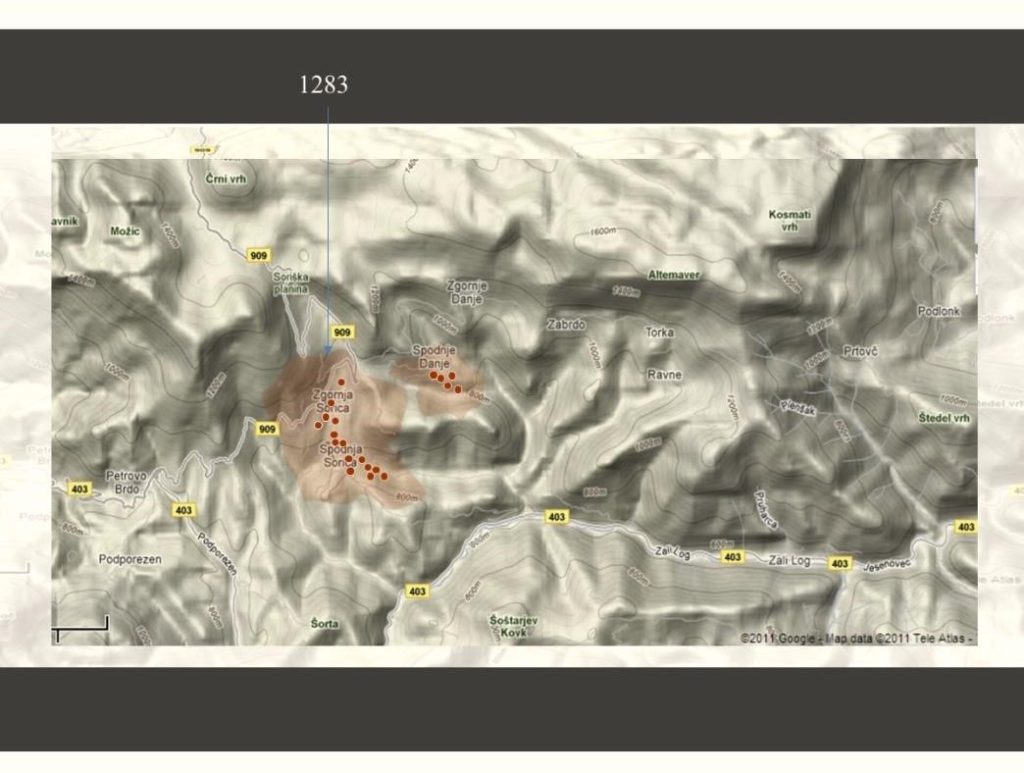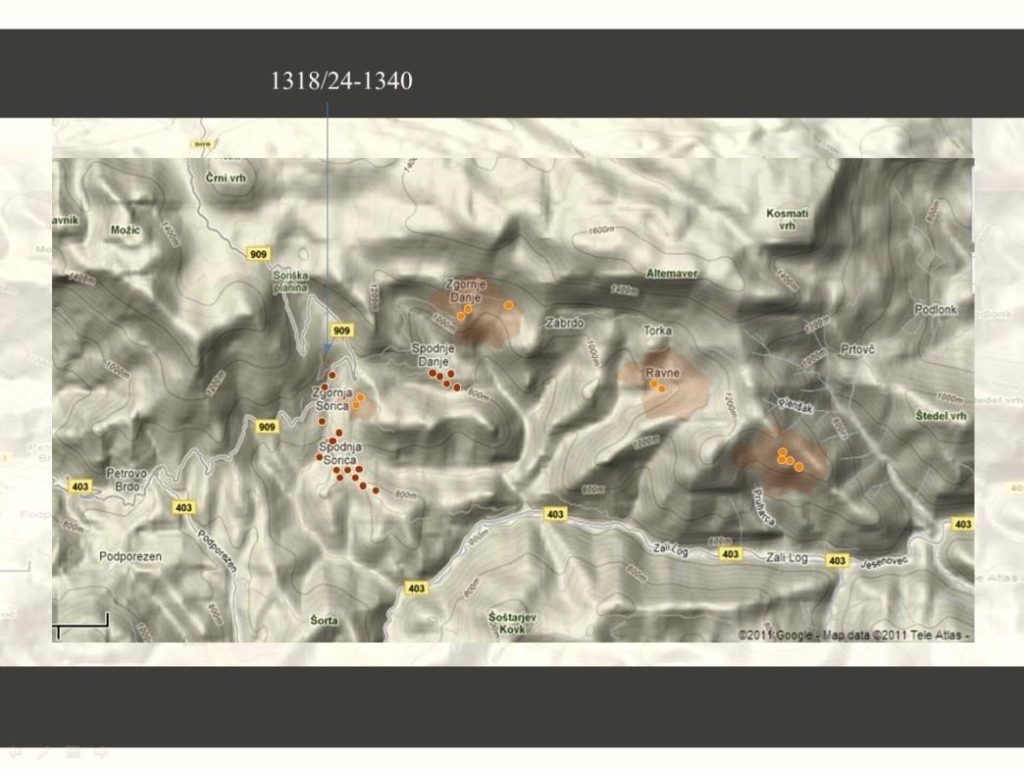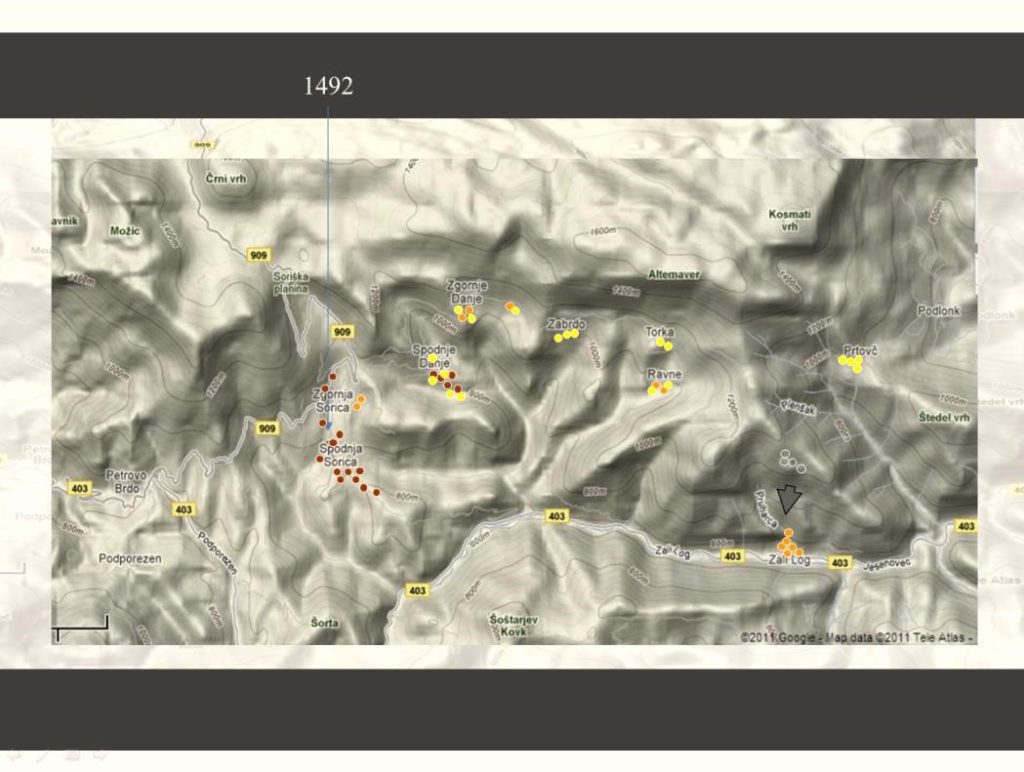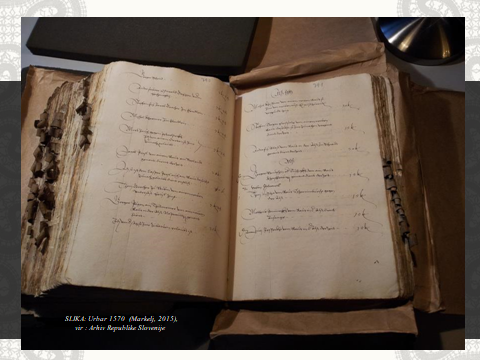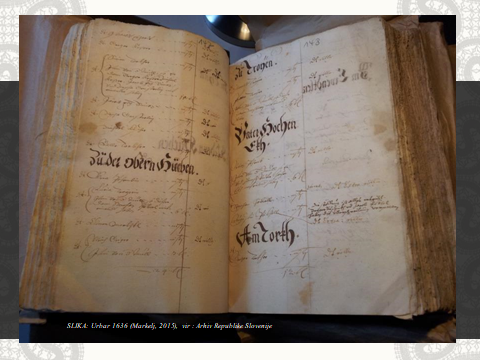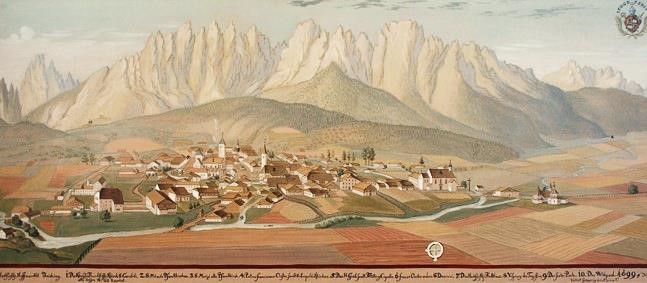History of Sorica and its surrounding
The first settlements on the steep slopes and overhangs of the narrow valleys of the upper part of the Selška valley began to emerge in the late medieval period, or more precisely at the end of the 13th century, which is confirmed by the archaeological picture and the individual archaeological finds found so far at Ratitovec and in the area called Zgornji Povden, which for the area show isolated fragmentary pieces of ceramics and charcoal, but not yet a permanent settlement.
The first settlers in the area were the Tyroleans from Innichen and its surroundings in the Pustriška valley in South Tyrol, who were settled by the then Freising bishop Emiho, master of the land, on these hitherto uninhabited sunny slopes of the Julian Alps. Before the Tyrolean settlement, in the early medieval document from 973, some toponymic terms were already used for the areas of the upper part of the valley, such as: mountain Pečana ( lat. Alpem Bosangam ), the territory of Sorica (lat. Zouriza ) and the river Sora (lat. Zoura ), however, none of the names refer to the name of the settlement.
Mountain villages, as well as buildings within the villages themselves, began to emerge at the end of the 13th century, as evidenced by records in the Freising Loka land register from 1291, which reads as follows:
»In der Zaevritz sunt 20 huebe culte e seruientes schillingum, harreht et steuram tantum. Ex hiis preco, qui eisdem pro tempore prefuerit habet unam racione sui officii « (transcription of urbar, cf. Figure 1 below ). From the above we can understand that in the area of Sorica in 1291 there were already 20 cultivated hubs (farms), which also still serve.
According to other records in archival sources, however, it can be concluded that the time from the foundation of the farm to the time when it began to be used was on average several years, which is why a later source from the 17th century, namely a note by Bishop Hren of Ljubljana in 1609, records the following:
» Anno 1283 Emicho, Episcopus Frisingensis, traduxit colonias, ex valle Pustertal, in viciniam Locopolis, et ibi constituit pagos Feuchtig et Zayrn, ubi adhuc hodie germanicam linguam callent Coloni« ( Blaznik, 1928), prikaže, da je v letu 1283 freisinški škof Emiho, lastnik ozemelj iz Pustriške doline, v bližini Loke v okolici Sorice ustanovil naselja, kjer prebivalci še danes govorijo germanski jezik.
The mentioned secondary source thus confirms the preserved data of land registers and clearly defines the time of settlement.
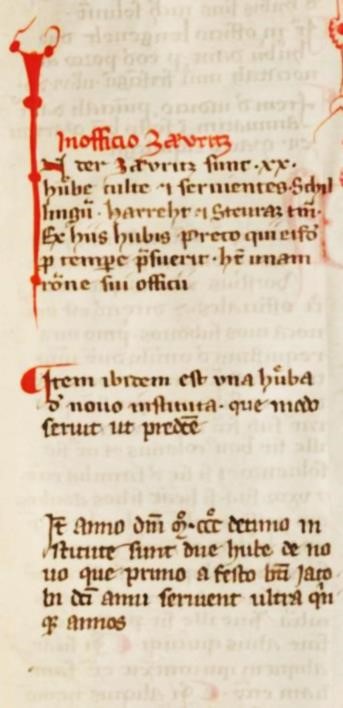
Initially, farms were established on the territory of Spodnja and Zgornja Sorica (germ. Zum Nidern ) and Spodnje Danje (germ. Niderenhueben ), further, with new settlements and internal expansion of the population, other mountain villages and hamlets were formed, such as: Zgornje Danje (germ. Oberenhueben ), In the valley (Im Thall), Trojar (Im Troy), Zabrdo (germ. Vndrenhoheneck ), Torka (germ. Thorek ), Ravne (germ. Ebendlein ), Michtal (germ. Michaelstall ), Zali Log (germ. Stuben ) in Prtovč (germ. Prietag ) ((see figures 2–5). ).
The primary settlement areas were both Zgornja and Spodnja Sorica and Spodnje Danje, which represented the core areas of a larger territory of the so-called Soriška parish (lat. Officium Zaevritz).
The villages grew very slowly over the centuries after settlement, preserving the primary farms and adding half and third farms, as well as individual cottages.
Population growth was constant, with the surplus population moving to a greater extent to the nearby areas of Podlonka, Davče, Podporezna, and Zalega Loga, and later with the development of ironworks also to Železniki. Outside the borders of the Selška valley, the inhabitants also settled in the territory of Nemški Rovto, in the area of Bohinj and in the area of Petrovo Brdo, on the border with what was then Goriška.
The Bavarian owners of the Sorbian properties granted land to the inhabitants of the mountain areas and side valleys around Innichen to develop the hitherto uninhabited area since their similar living conditions and the techniques of cultivating the steep hillside land made them the most capable of creating new village communities. “The geography of Pustertal is very similar to that of the Soriška territory. The absolute height (Innichen 1166 m, Toblach 1210 m) corresponds to the absolute height of the Podratitovo villages ”(Blaznik 1928, 48), which also affects a similar climate with cold winters and moderately warm summers, and both valleys also lie in an east-west direction. This is also the reason for the difference between the arable and the axis side, which is why various cultivated plants thrive up to an altitude of 1200 metres in both the Selška and Pustriška valleys, while higher up it has also been possible to establish alpine pastures, and the area is also rich in forest vegetation.
The land master thus granted the Sorice area to the inhabitants of his original feudal properties, and the land registers for 1305 and 1316 show that the area along the central part of the Pustrich valley between Abfaltersbach and Weisberg and the neighbouring valleys of Sexten, Kartitsch, Villgraten and Gsies fell under the lordship of Innichen, and thus under the area of the bishops of Freising at that time. The roots of Soriš ancestors can thus be traced back to the central part of the Freising feudal domain in South Tyrol, i.e. to the area of individual villages and hamlets in the immediate vicinity of the then market square of Innichen and the village of Vierschach. ( slo. Vršič ) in the Pustriška valley and on the sunny slopes of the side valley Sexten, which is still remembered by centuries-old and preserved family names and names of farms, such as: Gasser, Gaiger, Trojar, Kofler, Pfaifer, Frolich, Thaller (Toler), Pintar (Binatr) and others, which have been preserved in the area of Innichen and Sorica to this day.
The descendants of the larger farmers, who were no longer able to establish their (new) farms due to the lack of suitable land for expansion in the Pustica valley, established them in the area of Sorica and the remaining villages of the sub-ratitovce region.
Over the centuries, the inhabitants of Sorica have also maintained strong links and contacts with Innichen, where they used to make an annual pilgrimage to their schtift, or monastery church, where they would offer a large wax candle and a monetary indulgence, called Kafergeld, for a mass of intercession to be read to protect their fields. However, the residents still maintain good relations with Innichen in the form of annual cultural visits even today.
The people of the area are still largely preserving their ancestral cultural traditions, which date back more than 700 years and which are present in the area in the form of old customs, architectural features, the names of the fallow, cultural landscape and a specific language that is still spoken today.
Prepared by dr. Miha Markelj, in dec. 2020.
Historical highlights
- Archaeological sites explored »Zgornji Povden« and »Pečena«.
- A gift deed from the German Emperor Otto II to Bishop Abraham of Freising, dating from June 973, also mentions the first toponyms for the area of Sorice.
- Notice of the Bishop of Ljubljana Hren from the year a 1283gives us information about the settlement of the Tyroleans and the founding of Sorica.
- From the summer 1291we have the first written mention of the oldest farms in the Sorica area in the source of the Freising Loka land register.
- In the year 1655the oldest preserved registry book of the Sorica parish is created.
- Already more than 700years the link between Sorica and Innichen is maintained.
- Kafergeld is the name of the Sorbian levy on the stift church in Innichen.
- Zu Nidrn is the oldest name for Sorico, found in a document from 1492.
- Soriška dialect it represents a unique language with its grammar and vocabulary, which developed in the Sorica area and is still preserved in the form of the so-called “danjarske govornice” (Danjar dialect).
- In the dialect, the locals use the name Tsare for Sorico.
- With nice greetings from Sorica in dialect – an šeen grus aus de Tsare.
Recommendation for further reading
Popular, professional and scientific literature of Sorian history:
- Blaznik, Pavle. 1928. Kolonizacija Selške doline (Inavguralna doktorska disertacija). Ljubljana: Leonova družba Ljubljana.
- Blaznik, Pavle. 1973a. Škofja Loka in Loško gospostvo. Škofja Loka: Museum Society of Škofja Loka.
- Gasser, marija. 2014. Znamenja, kapelice, razpela v vaseh pod Ratitovcem. železne niti 11, str. 183-197.
- Gasser, Marija. 2015. Vasi pod Ratitovcem skozi čas = Drfe under Ratitovc durh’t cajt. samozaložba Marija Gasser
- Gasser, Marija. 2016. Cerkev sv. Nikolaja v Sorici. Železne niti 13, str. 167-184.
- Kejžar, Ivan. 2002. »Soriška ledinska imena«. Loški razgledi 49: 143–183.
- Kejžar, Ivan. 2004. »Sorica, njene vode in življenje ob njih«. Loški razgledi 51: 155–206.
- Kejžar, Ivan. 2008. Grohar in soriška dediščina. Škofja Loka: samozaložba Ivan Kejžar.
- Kejžar, Ivan. 2013. Atlas Soriška ledinska imena. Škofja Loka: samozaložba Ivan Kejžar.
- Kranzmayer, Eberhad in Lessiak, Primus. 1944. Die deutsche Mundart von Zarz in Oberkrain. A, Grammatik, Weimar : H. Böhlau Nachfolger.
- Kranzmayer, Eberhad in Lessiak, Primus. 1983. Wörterbuch der deutschen Sprachinselmundart von Zarz/Sorica und Deutschrut/Rut in Jugoslawien, Klagenfurt : Verlag des Geschichtsvereines für Kärnten.
- Marin, Anja. 2015. Hišna imena v Zgornji in Spodnji Sorici : magistrsko delo. Maribor: Univerza v Mariboru, Filozofska fakulteta.
- Markelj, Miha. 2009. »Tirolska arhitekturna in urbanistična dediščina v vaseh zgornje Selške doline: razvoj arhitekture pod Ratitovcem ter tipološka umestitev objektov v slovenski prostor«. Diplomska naloga. Koper: Univerza na Primorskem, Fakulteta za humanistične študije Koper.
- Markelj, Miha. 2011. »Tirolska naselbina pod vrhovi Ratitovca iz 14. stoletja: Michtal, Michalestall, Zali Log«. Magistrsko delo. Koper: Univerza na Primorskem, Fakulteta za humanistične študije Koper.
- Markelj, Miha. 2012. »Selško jezero: raziskava o obstoju srednjeveškega jezera v zgornjem delu Selške doline«. Seminarska naloga. Koper: Univerza na Primorskem, Fakulteta za humanistične študije Koper (neobjavljeno delo).
- Markelj, Miha. 2013. »Arheološka podoba Selške doline: pomembnejša najdišča in najdbe Selške doline med halštatom in visokim srednjim vekom«. Železne niti 10: 43–76.
- Markelj, Miha. 2013. »Tirolska skupnost zgornjega dela Selške doline v poznosrednjeveški in novoveški literaturi«. Seminarska naloga. Koper: Univerza na Primorskem, Fakulteta za humanistične študije Koper (neobjavljeno delo).
- Markelj, Miha. 2014. »Stara Krajevna imena Selške doline, zgornji del doline nekdanji urad Sorica in vas Zali Log«. Železne niti 11: 17–34.
- Markelj, Miha. 2015. Measuring Tenant and Land Unite Continuity among the Tyrolean Settlers in the Upper Part of the Selščica Valley, 5th Interdisciplinary Doctoral Conference Proceedings Book, in print.
- Markelj, Miha. 2019. Višinska kolonizacija zgornjega dela Selške doline : primer razvoja posestne in populacijska strukture tirolske naselitve iz konca 13. stoletja : doktorska disertacija. Koper: Univerza na Primorskem, Fakulteta za humanistične študije Koper.
- Markelj, Miha. 2020. Tiroler Siedlungen im nordwestlichen Slowenien Die Geschichte der mehrere Jahrhunderte währenden Verbindungen zwischen Innichen und dem Gebiet Sorica (Zarz). Der Schlern, str 32-54.
- Markelj, Miha, Jensterle, Boris in Hoffman, Andrew D. Nekdanje Soriško narečje – danjarska govorica, »drfaška špraha«: zgodovinski oris nastanka in kasnejši razvoj. Železne niti 17, str. 181–196. 181-196.




